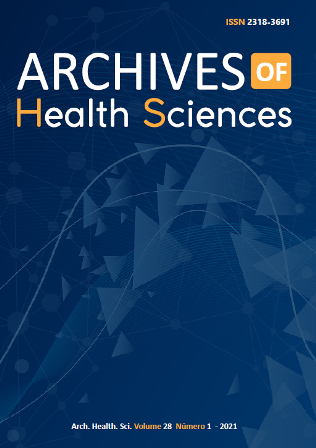Physical Activity for a Woman with Churg Strauss Syndrome: Case Report
DOI:
https://doi.org/10.17696/2318-3691.28.1.2021.1671Keywords:
Resistance Training; Immune system; Adrenal Cortex HormonesAbstract
Introduction: Churg Strauss Syndrome (CSS) is an autoimmune disease of undetermined etiology. Its diagnosis can be difficult, not only because of its rarity, but also because of the clinical and anatomopathological overlapping that could be present among different vasculitis; for this reason, it may have an underestimated CSS prevalence Systemic manifestations include myalgia, fever, weight loss, arthralgia, skin changes, peripheral neuropathy, pulmonary involvement, gastrointestinal tract involvement, and cardiomyopathy. Glucocorticoids are commonly used to fight the effects of the disease, however, these have important side effects, such as centripetal obesity, “full moon face”, gibe or “buffalo hump”, osteoporosis, weakness, myopathy, muscle atrophy, aseptic necrosis of the femoral head and humerus, and decrease of the immune system function. Objective: To report a unique case of a patient diagnosed with CSS for 10 years, who is undergoing treatment with corticoids and physical training to fight the side effects of pharmacological treatment. Case Report: To fight the side effects of this treatment; strength training (ST) and running were introduced. The patient underwent strength training three to five times a week throughout the treatment period so far. The load used in her training ranged from 50 to 70% of 1 maximum repetition, according to the periodization, in addition to running twice a week with a subjective perception of effort between 4 and 6. Regular blood tests for eosinophil analysis, bone densitometry, and anthropometric evaluations were performed. The training has pointed out evidence of being useful in maintaining body composition and bone mineral density (BMD). Conclusion: FT and aerobic training are important strategies in fighting the effects of CSS as well as the corticosteroid treatment.
References
Barros JM, Antunes T, Barbas CSV. Síndrome de Churg-Strauss. J Bras Pneumol. 2005;31(Supl 1):S27-31. https://doi.org/10.1590/S1806-37132005000700008
Rao JK, Allen NB, Pincus T. Limitations of the 1990 American College of Rheumatology classification criteria in the diagnosis of vasculitis. Ann Intern Med. 1998;129(5):345-52. DOI: 10.7326/0003-4819-129-5-199809010-00001
Greco A, Rizzo MI, Virgilio A, Gallo A, Fusconi M, Ruoppolo G, et al. Churg-Strauss syndrome. Autoimmun Rev. 2015; 14(4):341-8. DOI: 10.1016/j.autrev.2014.12.004
Mouthon L, Dunogue B, Guillevin L. Diagnosis and classification of eosinophilic granulomatosis with polyangiitis (formerly named Churg-Strauss syndrome) J Autoimmun. 2014;48-49:99-103. DOI: 10.1016/j.jaut.2014.01.018
Mahr A, Mossiq F, Neumann T, Szczeklik W, Taillé C, Vaglio A, et al. Eosinophilic granulomatosis with polyangiitis (Churg–Strauss): evolutions in classification, etiopathogenesis, assessment and management. Curr Opin Rheumatol, 2014;26(1):16–23. DOI: 10.1097/BOR.0000000000000015
Longui CA. Corticoterapia: minimizando efeitos colaterais. J.Pediatr (Rio J.). 2007;83(5Supl):S163-71. https://doi.org/10.1590/S0021-75572007000700007
Francisco CO, Bhatawadekar SA, Babineau J, Reid WD, Yadollahi A. Effects of physical exercise training on nocturnal symptoms in asthma: systematic review. PLoS One. 2018;13(10): e0204953. DOI: 10.1371/journal.pone.0204953
Turk Y, Van Huisstede A, Franssen FME, Hiemstra PS, Rudolphus A, Taube C, et al. Effect of an outpatient pulmonary rehabilitation program on exercise tolerance and asthma control in obese asthma patients. J Cardiopulm Rehabil Prev. 2017;37(3):214-22. doi: 10.1097/HCR.0000000000000249
Scott HA, Gibson PG, Garg ML, Pretto JJ, Morgan PJ, Callister R, et al. Determinants of weight loss success utilizing a meal replacement plan and/or exercise, in overweight and obese adults with asthma. Respirology. 2015; 20(2):243–50. doi: 10.1111/resp.12423
Nguyen VH. Osteoporosis prevention and osteoporosis exercise in community-based public health programs. Osteoporos Sarcopenia. 2017;3(1):18–31. https://doi.org/10.1016/j.afos.2016.11.004
Santarem JM. Fisiologia do exercício e treinamento resistido na saúde, na doença e no envelhecimento. CECAFI - Centro de Estudos em Ciência da Atividade Física da Faculdade de Medicina da USP, 2007 [acesso em 2020 Mar 11]. Disponível em: https://biodelta.com.br/especializacao/Tabela 2. Composição corporal e medidas antropométricas de paciente com síndrome de Churg Strauss, tratada com corticoesteroide e que realizava exercício físico. Lins/SP, Brasil.Ano2010201220142017Percentual de gordura (%)28,421,626,422,78Massa corporal (Kg)60,257,260,057,8Cintura (cm)736771,571Abdome (cm)8474,58483,5Quadril (cm)98,593,5100,596,5
Arch. Health. Sci. 2021 28(1) 49-52
Schoenfeld BJ, Grgic J, Ogborn D, Krieger JW. Strength and hypertrophy adaptations between low- vs. high-load resistance training: a systematic review and meta-analysis. J Strength Cond Res. 2017;31(12): 3508-23. doi: 10.1519/JSC.0000000000002200
Zemková E, Kyselovičová O, Jeleň M, Kováčiková Z, Ollé G, Štefániková G, et al. Upper and lower body muscle power increases after 3-month resistance training in overweight and obese men. Am J Mens Health, 2017;11(6):1728-38. doi: 10.1177/1557988316662878
Joshua AM, D’Souza V, Unnikrishnan B, Mithra P, Kamath A, Acharya V, Venugopal A. Effectveness of progressive resistance strength training versus traditional balance exercise in improving balance among the elderly - a randomised controlled trial. J Clin Diagn Res. 2014; 8(3):98-102. doi: 10.7860/JCDR/2014/8217.4119
Moura DP, Mattos DMS, Higino WP. Efeitos do treinamento resistido em mulheres portadoras de diabetes mellitus tipo II. Rev Bras Ativid Física Saúde. 2006;11(2):32-8. https://doi.org/10.
Downloads
Published
Issue
Section
License

This work is licensed under a Creative Commons Attribution-NonCommercial-NoDerivatives 4.0 International License.










